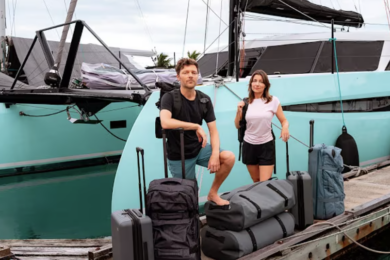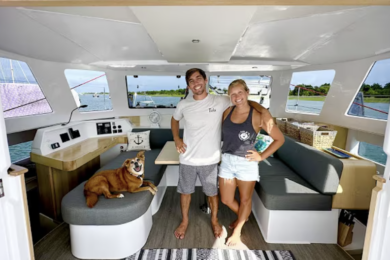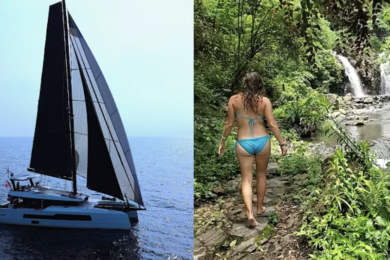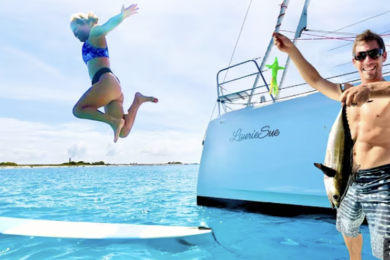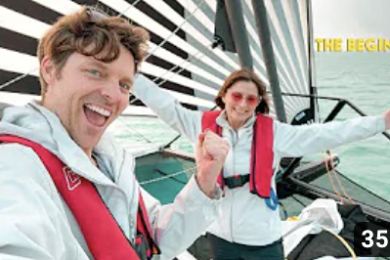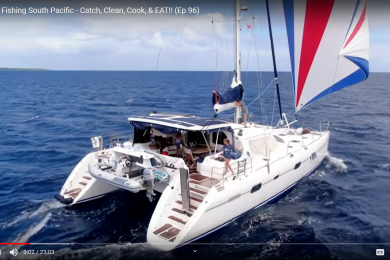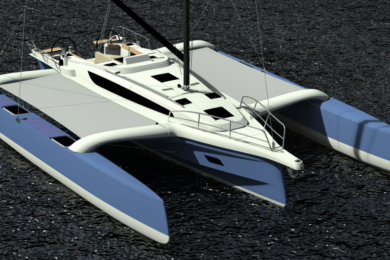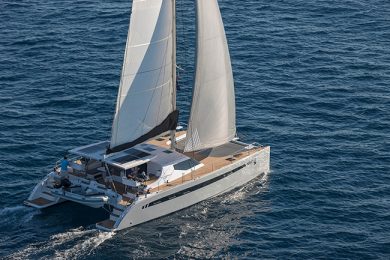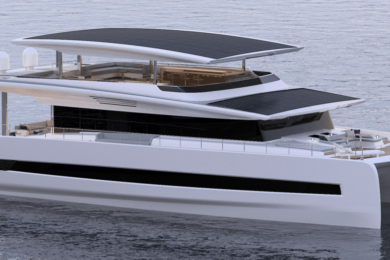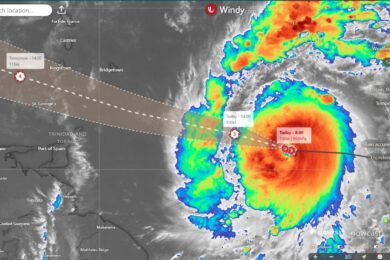“Avoid the crowd. Do your own thinking independently. Be the chess player, not the chess piece”-Ralph Charell (Published Spring 2015)
The British Virgin Islands have many features that attract sailors, and the island group is widely recognized as one of the best cruising grounds in the world. With islands strung parallel in a northeast to southwest direction just a few miles apart, a naturally protected Sir Francis Drake Channel is created, which gives cruisers numerous options for sailing. One can crisscross the channel with short, half-day sails to a pleasant lunch stop, and then enjoy an afternoon sail to a different anchorage for the evening.
Clear water for great snorkeling, mountainous islands with dramatic views, beautiful sunsets, and plenty of beach bars and open-air informal dining opportunities, it is easy to fill a week chartering or several months on your own yacht exploring the B.V.I. But by now you’ve probably spent time visiting the most popular spots in the islands. Places such as the Baths, the Indians, Marina Cay, Foxy’s, White Bay and the Soggy Dollar Bar, the Bubbly Pool, Cane Garden Bay, North Sound, the Dogs, Cooper Island, the wreck of the Rhone, The Bight, Anegada and many more.
So you want to get away from the crowds to experience what the Virgins were like in the 70s, which is when I first cruised these islands. Here are some anchorages you can add to your B.V.I. cruising plans to avoid the well-beaten path. Use your cruising guides, charts and eyeball navigation for these—most require anchoring.
VIRGIN GORDA
Eustatia Sound—take your boat into the Sound from North Sound along Saba Rock or from the north passing west of Eustatia Island. Do this in good light to easily spot and avoid the reefs and shallow water. Anchor southwest or west of Eustatia Island in sand, or west of the northern or southern half of Eustatia Reef, or in Deep Bay. Snorkeling behind the reef is excellent. If you tie your dinghy to the mooring behind the north half of Eustatia Reef, some old canon barrels are visible just east of the mooring. When northerly swells set in, monohulls may roll but it is just fine for multihulls. The views from anywhere in this anchorage are spectacular, with the varied colors of the sound, the ocean swells breaking on the barrier reef, and the smell of tropical vegetation and warm salt air stimulating your senses.
Long Bay, south of Mountain Point—tuck up into the notch southeast of Mountain Point (northwest corner of Virgin Gorda) and anchor in 24 feet. This anchorage has a nice beach, good snorkeling just south of the anchorage and at Mountain Point, and a broad view of Sir Francis Drake Channel to the west, which provides excellent island silhouette sunsets.
Savannah Bay—located on the west coast of Virgin Gorda above Spanish Town. Enter at the south end of the bay keeping the reef to your port side and staying well off Blowing Point. Once past the off-lying reef, turn northeast to stay between the reef extending out from shore and the off-lying reef. Anchor in sand, and be careful to avoid dark coral heads sprinkling the bay. Some sand bores allow access to a beautiful beach, with great snorkeling along the inner reef just off the beach. We’ve seen plenty of lobster, stingray, squadrons of squid, and many varieties of reef fish here. With a northerly swell from a distant storm, this anchorage can be rolly for monohulls, but most times it is just fine for multihulls. Avoid this anchorage though if large breakers are sweeping across the reef from larger northerly swells.

TORTOLA
Buck Island—off Hodges Creek and Maya Cove. This is a nice anchorage with great views across Sir Francis Drake Channel. Anchor toward the sand beach on Buck Island in 10 feet of water, being careful to find sand and avoid large patches of sea grass. When winds are to the southeast, this anchorage can be a bit rolly, but is just fine for multihulls.
Bluff Bay, Beef Island—when winds are to the east-northeast or northeast, this can be a good anchorage. Passing ferries provide a bit of wake, but other than that this is usually fine. Anchor along the south shore of Beef Island in the area shown on the charts as Bluff Bay. Come straight into Bluff Bay, or anchor outside the reef and rock line. The curve of Beef Island provides protection, and you are out of the flight paths for airplanes landing at Beef Island Airport. From here you have a panoramic view of Sir Francis Drake Channel.
COOPER ISLAND
At Cooper Island you can pass by the boats on moorings, and go south around Cistern Point to Haulovers Bay. Anchor in the lee of the notch on the island that splits the two halves of the island. The wind will funnel through here, but it keeps the bugs off. Great snorkeling is found at the rock off Cistern Point. And it is an easy dinghy ride from this anchorage to Cooper Island Beach Club.
PETER ISLAND
Deadman’s Bay—tuck up as close as you can in the southeast corner of the bay inside Cabey Point and anchor in sand. Good snorkeling is found at Cabey Point and along the southwest shore of the bay. Deadman’s Bay Beach Bar is open to cruisers. You’ll be humming the rhyme “Fifteen men on the Deadman’s Chest. Yo, Ho, Ho, and a bottle of rum. …” as you gaze over at Dead Chest Cay and think of Blackbeard’s notorious revenge on a mutinous crew.
Little Harbour—deep water in the harbor and tall hills that create back-winding dictate a different method of anchoring. The accepted practice for many years has been to drop a hook about 200 feet offshore and back stern to shore in the northeast corner of the bay, or along the south shore. Take a line to shore with the dinghy or snorkel gear and tie it to a large boulder or tree. You’ll have attractive close-up views of island vegetation and rocks off your stern as you sip your painkillers—maybe even seeing an iguana or wild sheep. And you’ll find great snorkeling right at the boat. You may share the anchorage with a few experienced off-duty crewed charter boats hanging out here enjoying the pastoral scenes and quiet setting.

Key Cay—this small anchorage is at the southwest corner of Peter Island at Key Point. Come in with the sun high or after noon, passing between the clearly shallow bars north and south of the anchorage. There is room for three or four boats at most, but you are often on your own. A neat short hike and great view can be had from the hill northeast of the anchorage, accessed from the gravel and sand beach.
White Bay—on the south side of Peter Island. Eyeball your way into the northeast corner of the bay and anchor in 25 to 30 feet. You are often back-winded here, so drop the hook far enough out to allow swinging room toward shore. If the trades clock southeast, this anchorage can be rolly for monohulls, but is usually fine for multihulls.
NORMAN ISLAND
Benures Bay—located on the north side of Norman Island. Anchor in 15 to 20 feet in the northeast corner of the bay off the gravel beach. You’ll find excellent views of Peter Island to the east and Tortola to the north.
Kelly’s Cove—located just north of The Bight, and out of view of the large fleet in The Bight in high season. Only five or so moorings are here, and one should not be surprised to be back-winded. But the views of rocky cliffs off your stern and the sunsets are dramatic. Excellent snorkeling can be had along the north shore of the cove.
LITTLE JOST VAN DYKE

Green Cay—anchor in sand at a depth of 12 to 15 feet. You can dinghy to either Green Cay or Sandy Spit. You’ll usually have a couple boats here with you, but it is much less crowded than the moorings off Foxy’s Taboo. Views of Jost Van Dyke, and the tall elevations of Tortola and St. John are attractive from this anchorage.
GREAT CAMANOE
Lee Bay—off the southwest corner of Great Camanoe. Anchor in sand in the northeast corner of the bay off the beautiful beach. This anchorage is also rarely visited, but well protected other than in northerly swells.
GUANA ISLAND
White Bay—at the southwest corner of Guana Island. This is a very attractive, rarely visited spot with good holding in sand in 15 to 25 feet. Anchor off the north end of the beach for better protection from swells. The point off the northwest corner of this bay provides the rock outcropping that looks like the head of an iguana, and is the namesake for the island. Nearby Monkey Point is more frequently visited as a day stop, with National Park moorings and good snorkeling off the point.
Sailors visiting the B.V.I. by charter or on their own yachts have a great opportunity to add some of these gems to their cruising plans. And I look forward to seeing you there.
Hank and his wife Seale have been lifelong sailors and made the switch to a Catana 471 performance cruising catamaran almost seven years ago after owning and sailing monohulls from 22 to 52 feet for 45 years. They have each logged over 128,000 blue water miles.

